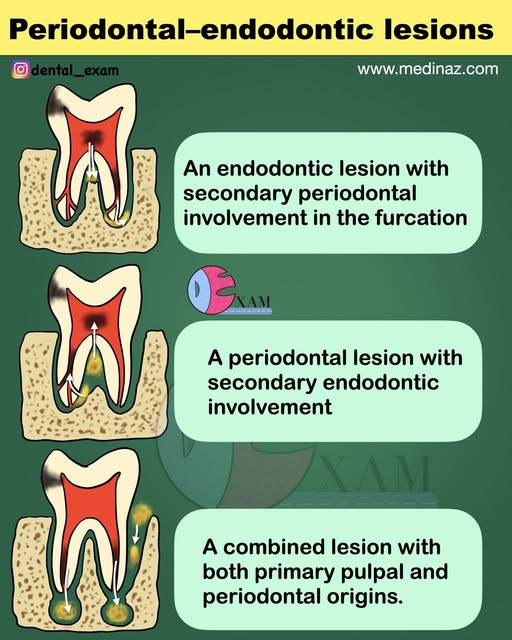Modern Dentistry, Timeless Smiles.
Precision in Healing: Understanding Periodontal - Endodontic Lesions and the Power of Flap Designs in Dental Surgery
Language :

Inside every tooth lies a delicate balance between the pulp (nerve tissue) and the periodontium (supporting bone and gum). When infection strikes one, it can spread to the other — forming what dentists call a periodontal–endodontic lesion.
These lesions are complex and require both root canal therapy and periodontal (gum) surgery for complete healing.
Types of Periodontal–Endodontic Lesions
-
Primary Endodontic Lesion with Secondary Periodontal Involvement
– The infection starts in the pulp and extends outward toward the gum, often through the apex or furcation area. -
Primary Periodontal Lesion with Secondary Endodontic Involvement
– Begins with gum disease that travels down the root surface and eventually affects the pulp. -
Combined Lesion
– Infection arises from both pulp and periodontium simultaneously, making treatment more complex.
Root and Tooth Holding Analysis
-
The root acts as the foundation of the tooth — anchored in bone via the periodontal ligament.
-
When infection reaches the root tip or lateral canal, the bone around it resorbs, weakening tooth stability.
-
Proper diagnosis (via X-ray or CBCT) determines whether healing will occur after endodontic treatment alone or if a surgical flap must be performed to remove infection and regenerate bone.
Clinical Story: The Healing of Pedro and His Friends
Pedro — The Envelope Flap
Pedro had a deep gum pocket near his molar roots. The dentist created an Envelope Flap, a simple gum reflection along the tooth margin, to access and clean the infected area. This design minimizes trauma and allows for quick healing and easy suturing. Within 14 days, Pedro’s gums reattached beautifully.
Smith — The Szmyd Flap
Smith’s case involved a deeper lesion between teeth. His dentist used a Szmyd Flap, which provides greater access by extending into the interdental papilla without excessive stretching. Healing took slightly longer (about 3 weeks), but the result was stable tissue and full recovery.
Peter — The Triangular Flap
Peter needed access to a large endodontic lesion near the front tooth root. A Triangular Flap (one vertical incision + horizontal) was made. This offered wide access and excellent visualization for cleaning the lesion. Healing time: 2–3 weeks, with minimal scarring.
Mark — The Modified Envelope Flap
Mark’s case required delicate precision near the gumline. The Modified Envelope Flap allowed targeted debridement while preserving papillary tissue. Healing was fast — around 10–14 days, with natural gum contour maintained.
Tony — The Modified Szmyd Flap
Tony had a combined periodontal–endodontic lesion. His dentist performed a Modified Szmyd Flap, ideal for aesthetic zones, providing access without papilla loss. After root planing, grafting, and suturing, Tony’s gums regenerated steadily over 3–4 weeks.
Brian — The Modified Triangular Flap
Brian’s molar lesion extended into bone. The Modified Triangular Flap allowed for bone graft placement and root-end cleaning. Postoperative results showed bone regeneration and firm gum attachment after 1 month.
Healing Timeline Overview
| Flap Type | Access | Healing Period | Ideal Case |
|---|---|---|---|
| Envelope | Moderate | 10–14 days | Simple root cleaning |
| Szmyd | Deep | ~3 weeks | Interproximal lesions |
| Triangular | Wide | 2–3 weeks | Front tooth access |
| Modified Envelope | Precise | 10–14 days | Aesthetic zones |
| Modified Szmyd | Conservative | 3–4 weeks | Combined lesions |
| Modified Triangular | Extensive | 1 month | Bone graft cases |
Conclusion
Every case of periodontal–endodontic lesion demands a personalized surgical approach.
Through the experiences of Pedro, Smith, Peter, Mark, Tony, and Brian, we see how flap designs guide precise treatment, promote faster healing, and restore both function and beauty.
Early diagnosis, advanced imaging, and proper flap selection can make the difference between tooth loss and complete recovery.
Main Category Placement
| Category | Relevance | Notes |
|---|---|---|
| Periodontal Treatments | High | Covers gum and bone procedures, flap surgeries, and periodontal healing. |
| Endodontic Treatments | High | Discusses root canal–related infections and lesions of pulpal origin. |
| Oral Surgery | Medium–High | Includes flap design and surgical access for debridement and bone regeneration. |
| Clinical Case Stories | High | Story-based explanation of six patient cases (Pedro, Smith, Peter, Mark, Tony, Brian). |
| Dental Education / Blog Articles | High | Informative, educational content for both professionals and patients. |
| Healing and Recovery Guides | Medium | Discusses healing timelines and outcomes per flap type. |




